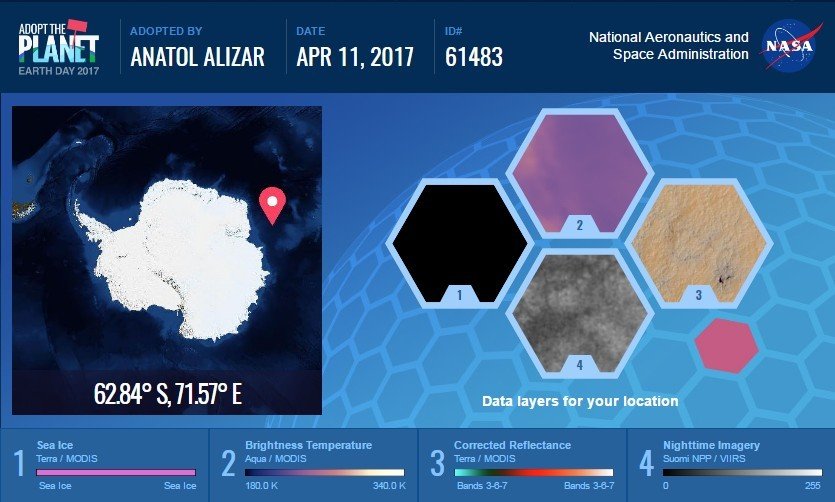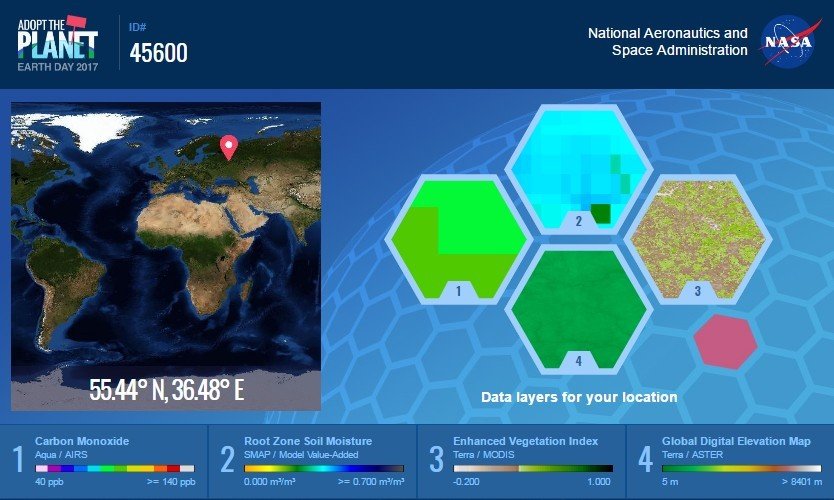NASA

April 22, 2017 around the world will celebrate Earth Day – an event designed to encourage people to be more attentive to the fragile and vulnerable environment on planet Earth. Last year, on that day, 120 countries signed the Paris Agreement in the stamps of the United Nations Framework nasa Convention on Climate Change, which regulates measures to reduce carbon dioxide in the atmosphere since 2020. Maybe it’s naive, but there is a hope that coordinated efforts of states will eventually stop the heating of the planet.
This year NASA joined the events of Earth Day 2017. The agency invites all citizens of the world to take part in a touching action – and “adopt” one of 64,000 pieces of our planet, take over it patronage.
The study of the Earth is the main scientific task that faces NASA. Conquering the distant boundaries of the cosmos, studying the Sun, the Moon, Mars and other cosmic bodies are already secondary tasks.
“NASA continues its uninterrupted searches and studies of planets in our solar system and beyond, but no planet has been studied Better than the one on which we live, – said in a press release. “Our fleet of 18 space science exploration missions, with the support of aircraft, ships and ground-based observations, measures aspects of the environment that affect the lives of everyone around the world.”
As part of the popular science project Adopt The Planet Each participant can “adopt” a small piece of the Earth about 80 × 80 km in size. Choose a piece of your own will not work – it remains to rely on the will of the lot. And do not be disappointed if you lost a lifeless nickle near Antarctica, because every corner is precious on our home planet.

The participant receives a personal certificate of adoption of a piece of the Earth, it can be printed or Publish in social media.
Together with the site of the planet you are given scientific data about it, collected in the framework of scientific projects of NASA. For example, the certificate above shows:
- the amount of sea ice (the Moderate Resolution Imaging Spectroradiometer (MODIS) tool from the Terra and Aqua satellites);
- brightness temperature, which characterizes the intensity of radiation and shows how much energy is reflected from clouds, earth and water and other objects. Measurements of the brightness temperature are performed by the same MODIS spectroradiometer;
- corrected reflectance, the picture is composed of different parts of the spectrum: the visible part of the spectrum Band 3 (shown in red), the short-wave infrared Band 6 and Band 7 (green and blue),
- nighttime imagery, performed by the Visible Infrared Imaging Radiometer Suite (VIIRS) instrument, installed on the joint NASA and NOAA Suomi National Polar Orbiting Partnership (Suomi NPP) satellite.
For other sites, the certificate may reflect other data collected by NASA, including carbon monoxide (CO) content in the atmosphere, chlorophyll concentration in the ocean, cloud height, vegetation density (Enhanced Vegetative Index), soil moisture in the root zone (Root Zone Soil Moisture), altitude above sea level, ozone concentration at an altitude of 20 km, relative humidity at an altitude of 1.5 km, ocean surface temperature, snow cover.

From a personal certificate On the coordinates of its part of the planet You can go to the Worldview site, which visualizes information from the Earth Observing System Data and Information System (EOSDIS). Nearly in real time (with an update every three hours), NASA’s scientific observations are collected.
NASA expects that until April 22, the earthlings will be taken to adopt all 64,000 available fragments of the Earth. If this happens before, then it’s okay: the distribution will start from the very beginning for the second time, so that no one will be left without a piece. Judging by the number of issued fragments at the moment (about 62 000), by Earth Day every few pieces of the planet will have several foster parents at once.








